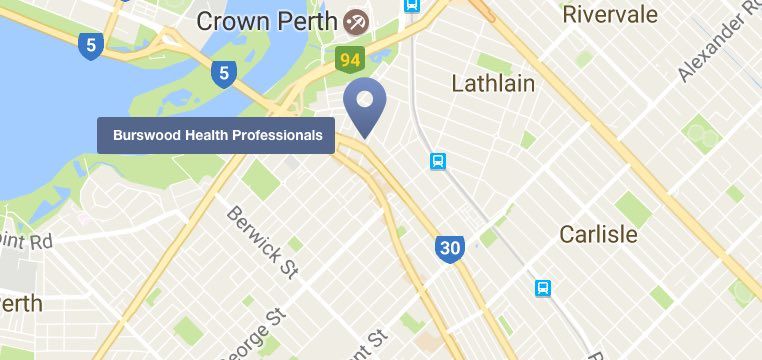General Foot Care
Common foot problems are often the result of disease, years of wear and tear, ill-fitting or poorly designed shoes, poor circulation to the feet, or improperly trimmed toenails. Many of these problems can be avoided with proper foot education as, if not treated promptly, foot problems can become chronic and difficult to cure.
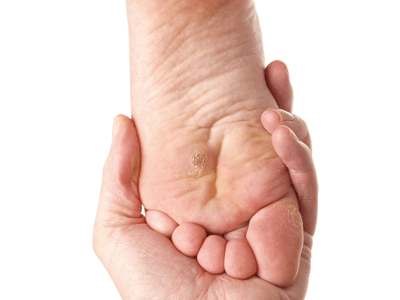
Foot Education Can Help Prevent Foot Trouble
Many people are unaware of aspects of foot education that help in treating common foot problems. Improving the circulation of blood to the feet can help prevent complications.
Poor circulation can come from exposure to cold temperatures or water, pressure from shoes, long periods of sitting. Smoking can also reduce blood flow to the feet. Even sitting crossed legged or wearing tight, elastic garters or socks can affect circulation.
Understanding Common Foot Problems
Ageing Feet
As we age, we naturally develop more problems with our feet due to normal daily wear and tear of joints.
What causes the problem?
As we age, we naturally develop more problems with our feet due to normal daily wear and tear of joints, but also because the skin starts to become thin and loses its elasticity, as well as being dry and much more fragile.
The consequences of ageing feet
Foot pain can be debilitating. As we only have one pair of feet, it’s important to take good care of them. Foot pain can also lead to issues with walking and exercising which are an important part of health and wellbeing as we age.
Additionally, if we have trouble with mobility, this can impact on getting out and about and involvement in social activities which become ever more important as we get older. As long as we take routine care of our feet, serious problems can usually be avoided, however, ageing can also mean that we develop other conditions, such as diabetes and arthritis, which in some cases can affect the foot and lead to requiring treatment. Healing may also take longer. Foot pain can be debilitating. As we only have one pair of feet, it’s important to take good care of them. Foot pain can also lead to issues with walking and exercising, which are an important part of health and well-being as we age.
Other Pain You Might Feel
General Foot Conditions
Think you have a common foot condition? Read more about potential foot problems and how we can help.
Anything I can do to prevent my feet from ageing?
Feet can start to show signs of ageing at any age if good routine foot care is not practiced, but generally, it is most common from your fifties onwards. General signs of ageing feet include more regular aches and pains, developing bunions, signs of clawing of the toes along with general circulatory problems.
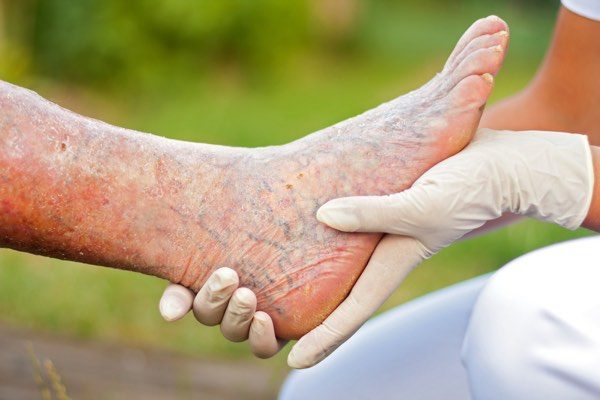
Athlete's Foot
Athlete’s foot is a skin fungal infection. It can lead to intense itching, cracked, blistered or peeling areas of skin, redness and scaling. It can occur on moist, waterlogged skin usually between the fourth and fifth toes initially, or on dry, flaky skin around the heels or elsewhere on the foot. Large painful fissures can also develop and the condition can also spread along all five toes and sometimes to the soles of the feet if left untreated.
What causes athlete's foot?
It’s caused by a number of fungal species which you can pick up from someone else shedding affected skin (typically in communal areas such as pools, showers and changing rooms) or where you may walk around barefoot. Athlete’s foot can also be passed on directly from person to person contact, although people who sweat more are much more prone to infection.
Once your feet have been contaminated, the warm, dark and sweaty environment of feet cramped in shoes or trainers provides the ideal breeding ground for the fungus. However, athlete’s foot also occurs in dry, flaky areas. It’s quite common in summer with sandal wearers. Treating common foot problems like Athlete's Foot is from the sun making your skin dry out so it loses its natural protective oils. This combined with the constant trauma from sandals makes them more prone to infection.
Bunions
More than 15% of women in the UK suffer from bunions, but what is a bunion? A bunion, also known as ‘hallux valgus’ is a deformity of the big toe in which the big toe excessively angles towards the second toe and leads to a bony lump on the side of the foot. This can also form a large sac of fluid, known as a bursa, which can then become inflamed and sore.
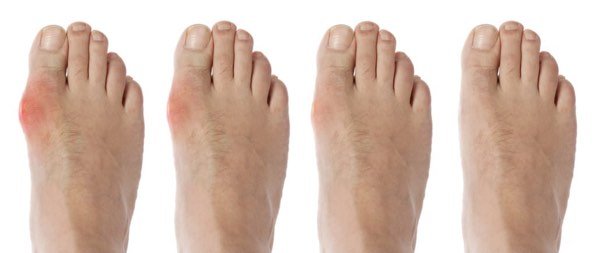
How come we get bunions?
There is no one cause of having a bunion and contrary to popular opinion, bunions are not generally caused by shoes. They are most often caused by a defective mechanical structure of the foot which is genetic and these certain foot types make a person prone to development of a bunion.
Bunions can also be caused from the big toe pushing over on to the second toe which can lead to problems. Commonly, it can end up lying on top of the second toe causing crossover of the toes making it difficult to walk due to pressure on the toes from footwear.
Once the big toe leans toward the second toe, the tendons no longer pull the toe in a straight line, so the problem tends to get progressively worse. This condition can also lead to corns and calluses being developed.
Poorly fitting footwear tend to aggravate the problem as they can squeeze the forefoot, crowding the toes together and exacerbate the underlying condition, causing pain and deformity of the joint (hallux valgus).
Bunions can also be caused by age, arthritis or playing sport.
Corns and Callus
When we walk or stand, our body weight is carried first on the heel and then on the ball of the foot, where the skin is thicker to withstand the pressure. When this pressure becomes excessive, some areas of skin thicken in the form of corns and callus, as a protective response to the body’s reaction to the friction of skin rubbing against a bone, shoe or the ground.
Callus (or callosity) is an extended area of thickened, hard skin on the soles of the feet. It is usually symptomatic of an underlying problem such as a bony deformity, a particular style of walking or inappropriate footwear. Some people have a natural tendency to form callus because of their skin type. Elderly people have less fatty tissue in their skin and this can lead to callus forming on the ball of the foot.
Corns are caused by pressure or friction over bony areas, such as a joint, and they have a central core which may cause pain if it presses on a nerve. There are five different types of corns, the most common of which are ‘hard’ and ‘soft’ corns:
- Hard corns – these are the most common and appear as a small area of concentrated hard skin up to the size of a small pea usually within a wider area of thickened skin or callus. This may be a symptom of the feet or toes not functioning properly.
- Soft corns – these develop in a similar way to hard corns but they are whitish and rubbery in texture and appear between toes where the skin is moist from sweat or from inadequate drying.
- Seed corns – these are tiny corns that tend to occur either singly or in clusters on the bottom of the foot and are usually painless.
- Vascular corns – these can be very painful and can bleed profusely if cut.
- Fibrous corns – these arise when corns have been present for a long time and are more firmly attached to the deeper tissues than any other type of corn. They may also be painful.
Ingrowing Toenail
An ingrowing toenail is one that pierces the flesh of the toe. It can feel as if you have a splinter, be extremely painful and inflamed or infected. In more severe cases, it can cause pus and bleeding. Ingrowing toenails most commonly affect the big toenail, but can affect the other toes too. Whereas a nail that is curling (involuted or convoluted) into the flesh, but isn’t actually piercing the skin, isn't an ingrowing toenail but can feel very painful and also appear red and inflamed
What causes ingrowing toenails?
One of the most frequent problems encountered when treating common foot problems is an ingrown toenail. There are many genetic factors that can make you prone to ingrowing toenails including your posture (the way you stand), your gait (the way you walk) and any foot deformity such as a bunion, hammer toes or excessive pronation of the feet (when your foot rolls inward excessively). Your nails may also have a natural tendency to splay or curl out instead of growing straight, encouraging your nail to grow outwards or inwards into the flesh.
Tight footwear, hosiery and socks can also push your toe flesh onto the nail so that it pierces the skin.

Also, if you sweat excessively or don’t rotate your footwear, this makes the skin moist and weak so that it is easily penetrated by the nail. If you have brittle nails with sharp edges or are in the habit of breaking off bits of nail that are sticking out, you are also more likely to get an ingrowing toenail. In addition, the wearing of support hose that is ill-fitting and squeezes the toes or likewise, the wearing of shoes with tight toe boxes.
However, one of the most common causes is not cutting your toenails properly such as cutting nails too low in order to relieve the pressure and discomfort of an involuted nail. Less common is a fungal infection or in some cases particular types of medication, eg. isotretinoin.
Sweaty Feet
Most of us have suffered from foot perspiration and odour from time to time, yet for some people, sweaty feet (along with sweaty palms and armpits) are a persistent problem which can be embarrassing and uncomfortable. For some people, this can affect their day-to-day life considerably resulting in decreased social contact with others but the condition is treatable.
Sweaty feet is a complaint known as Hyperhidrosis (or excessive sweating) and has a lot to do with how the sweat glands in this part of the bodywork. With 250,000 sweat glands, feet do tend to sweat more than other parts of the body but with a daily hygiene routine, few people should suffer from the embarrassment that it may cause.
There are more sweat glands per inch in our feet than anywhere else in the body and their function is to keep the skin moist and therefore supple and regulate temperature when the weather is hot, if you have an unnaturally high temperature or while exercising. They secrete all the time, not just in response to heat or exercise, like elsewhere in the body.
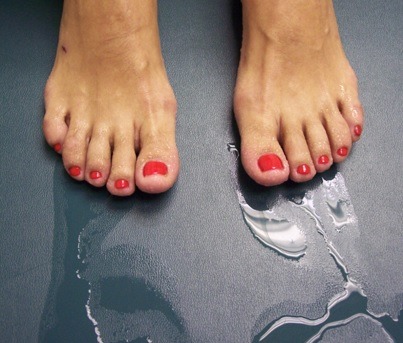
What causes sweaty feet?
Treating common foot problems like sweaty feet (along with palms and armpits and the face/scalp), tends to be symmetrical. The exact cause is unknown but due mainly to overactive sweat glands. In some cases, the cause can be genetic.
Possible other causes include stress on the foot sometimes caused by a structural problem or because the foot is under strain or tired, for example, when you have been standing on your feet all day.
Verrucae
Verrucae are plantar warts that commonly occur on the soles of the feet or around the toe area. They are caused by the Human Papilloma Virus (HPV) which is highly contagious through direct person to person contact. There are various forms of HPV which all relate to various parts of the human body.
What are the causes of verrucae?
The virus is thought to thrive in moist, damp environments such as swimming pools, changing room floors and communal shower areas. It is possible to contract verrucae simply by walking across the same floor area as someone with a verruca, especially if you have any small or invisible cuts or abrasions that make it easier for the virus to penetrate.
Working together on your treatment plan
When it comes to treating common foot problems, it pays to have your feet examined by a podiatrist if you have ongoing foot trouble. Just call to arrange an appointment to see how we can help you. A referral is not needed to attend a podiatrist treatment when claiming from your health fund.

